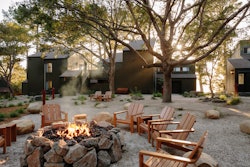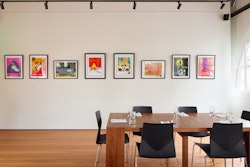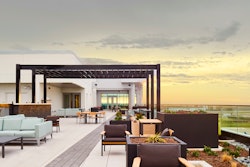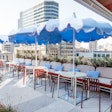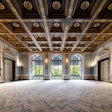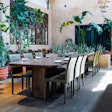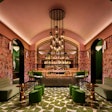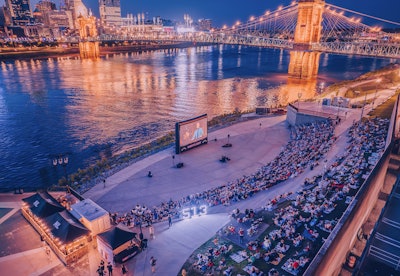
It’s no secret that sustainability remains a key theme in the event world. Beyond the greening elements integrated into events (think: water stations and reusable water bottle swag, food waste reduction efforts, and digital elements in favor of printed materials), it all starts with the venue itself.
We’ve recently noticed an uptick in the popularity of underutilized spaces nationwide. From outdoor entertainment experiences taking advantage of natural landscapes to food halls overtaking historical buildings to experiential warehouse transformations delivering surprise-and-delight moments, we got the inside scoop from seven industry experts on their top tips—amid challenges—to keep in mind while transforming existing spaces for your next event.
1. Expect older structures to come with limitations.
Cameron Forbes, founder of Forbes Functions, says underutilized spaces offer a blank canvas that can be tailored to fit specific event themes, aesthetics, and styles, making each event truly one of a kind. “There’s a growing appreciation for sustainability and the story behind a venue, which these spaces often provide. As the event industry continues to evolve, the desire for distinct, memorable venues drives the popularity of repurposing underutilized spaces,” she explains.But it’s important to be mindful of the potential for unforeseen challenges within an existing structure, according to Forbes. “Older buildings might need help with plumbing, electrical systems, or overall stability, which requires significant investment. Additionally, there may be limitations on how much the space can be altered, constraining creative visions. Navigating permits and zoning regulations for repurposed spaces can also be more complex than new constructions,” she shares.
The solution? “Start with a clear vision but remain flexible,” Forbes suggests. “My approach begins with thoroughly assessing the space to understand its unique characteristics, limitations, and potential. Forbes says conducting a thorough site inspection and working closely with the venue’s team to understand any limitations or necessary upgrades is crucial. “Build a network of reliable vendors who specialize in working with older buildings. Pay attention to the logistics, such as accessibility and parking, which can significantly impact the guest experience.”
2. Immerse yourself in the local culture and community.
Local Culture Management is a company that transforms significant venues and spaces into vibrant food halls and cultural hubs, including DeKalb Market Hall, ANA Bar & Eatery, The Hugh, and NINA in New York, with a new project in Chicago currently underway. CEO Anna Castellani entered the industry to create unique, community-driven dining experiences that showcase diverse cuisines and foster a sense of belonging. With the goal of revitalizing neglected areas, Castellani and team aim to turn the spaces over into popular destinations that are family-run and immigrant-owned businesses.Castellani notes that these investments involve risks, though, which require significant resources. “Despite these challenges, I believe in the value of creating culturally rich and authentic spaces,” she says. “By fostering community and attracting diverse customers, the long-term benefits to the developer often outweigh the short-term gains of conventional investments.”
When transforming neglected spaces, Castellani says the first thing you need to truly understand is the community. “Immerse yourself in their culture, history, and needs. Build authentic relationships with local leaders and residents to ensure the space resonates with their values. Prioritize family-owned and diverse vendors over generic fast-food chains to infuse the space with genuine character,” she offers.
By incorporating interactive elements and design, she continues, the environment can become inclusive and welcoming to everyone. “Be prepared for skepticism from investors; clearly communicate the long-term benefits and sustainable growth your vision offers,” she warns. “Reimagine the space creatively and highlight cultural diversity to turn overlooked locations into thriving, community-focused destinations.”
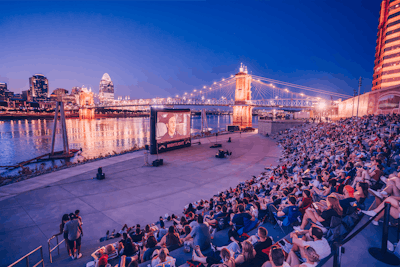 “Experiences in nontraditional settings make statements,” says NightLight co-founder Patrick Cline.Photo: Colin Peterman
“Experiences in nontraditional settings make statements,” says NightLight co-founder Patrick Cline.Photo: Colin Peterman
3. Use urban surroundings to make a statement.
NightLight Series is an experiential 21-and-up outdoor social cinema in cities like Nashville, Miami, and Columbus, Ohio. “What were common public spaces, lawns, or pavilions, we’ve transformed into intimate outdoor movie theaters,” shares co-founder Patrick Cline. NightLight essentially takes urban parks and repurposes the spaces to create an alfresco movie night under downtown skylines.“There are existing aesthetic elements, whether natural in the urban environment or architectural in the surrounding area, that have personality or a unique signature within the city,” Cline explains. “This is a strength that brands can utilize, magnify, and showcase in an authentic way to separate their experience from the commonly used spaces and venues in that market.”
Additionally, Cline says there are some magic aspects to an event that you simply cannot replicate or just “build,” like views, ornate historical architecture, natural beauty, skylines, the proximity to water, etc. “Experiences in nontraditional settings make statements,” he says.
4. Make the space feel like it’s been there all along.
Sarah Sebastian, owner and creative director of experiential event agency Rose Gold Collective, says that while an empty space can be a challenge, it’s the creative freedom that allows her to thrive. Rose Gold Collective recently conceptualized The Seltzer Shop pop-up in Miami and Chicago, which offered guests a chance to try different brands and flavors to celebrate the category. The mix of modern and midcentury-mod touches took guests into a pop-up soda shop transformed into an immersive tasting space.“We love working in raw, empty spaces to truly allow our design and scene to come to life,” says Sebastian. “While the challenge is, of course, covering a lot of space and bringing everything in, it’s satisfying for people to walk into the space and wonder, ‘What was even there before?’ We want to turn the space into something that feels like it has been there all along.”
5. Use interactivity thoughtfully.
Zero Empty Spaces is dedicated to transforming vacant commercial real estate into working artist studios that serve as vibrant hubs for creativity and community engagement.“We activate these spaces where artists can create and collaborate at an affordable price while having the ability to be discovered and sell artwork out of their studio,” shares co-founder and managing partner Andrew Martineau. “Our innovative approach addresses the challenge of urban blight and retail vacancies by temporarily occupying unused spaces until permanent tenants are secured by property owners.”
Through this model, Zero Empty Spaces breathes fresh life into new and neglected areas, fostering artistic expression and economic revitalization—all with the goal of expanding the appreciation of various genres of visual art and helping to create a thriving cultural community in more cities around the world.
In its various locations throughout Florida, Arkansas, Massachusetts, and Virginia, Zero Empty Spaces welcomes art-centric events. “This requires a thoughtful approach to both the art and the space itself,” says Martineau, who suggests prioritizing interactivity when planning the layout.
The process starts with designating clear zones. “Divide the space into distinct areas for live art demonstrations and interactive projects,” he suggests. “This will help manage the flow of guests and ensure that each activity has enough room to be fully appreciated. Then, ensure accessibility. Arrange the space so that guests can easily move between different areas without disrupting the artists at work. Consider the sightlines so that everyone can have a good view of the demonstrations.”
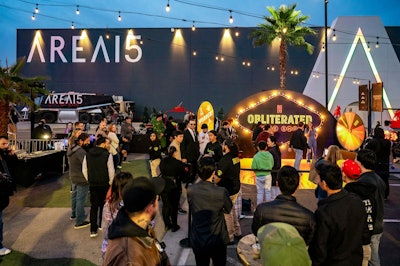 "It’s not just about filling the empty space; it’s about layering in memorable surprise-and-delight elements that leave a lasting impression," says AREA15 director of brand partnerships Jillian Austin.Photo: Courtesy of AREA15
"It’s not just about filling the empty space; it’s about layering in memorable surprise-and-delight elements that leave a lasting impression," says AREA15 director of brand partnerships Jillian Austin.Photo: Courtesy of AREA15
6. Create surprise-and-delight moments.
Just minutes from the Las Vegas Strip, award-winning AREA15 is a dynamic and immersive 200,000-square-foot complex consisting of previously built warehouse spaces available for innovative and inspired corporate buyouts specializing in experiential partnerships and events.“Transforming an existing space into the ultimate brand pop-up experience is all about creating unexpected moments that captivate and engage your audience," says Jillian Austin, director of brand partnerships. "It’s not just about filling the empty space; it’s about layering in memorable surprise-and-delight elements that leave a lasting impression such as an unexpected art installation, an immersive experience, or a unique sensory twist."
Austin says at the recent Percy Jackson and the Olympians activation, her team elevated the visitor experience with a surprise photo moment with colorful artwork and the opportunity to meet actress Olivea Morton, leaving hundreds of fans with unforgettable memories.
Additionally, when working with Netflix to bring Army of the Dead: Viva Las Vengeance from an ordinary VR experience to an unforgettable one, Austin and her team provided guests with the opportunity to take pictures in front of the film’s iconic taco truck before their adventure. “Elevating the space into what felt like an apocalyptic scene from the movie with the use of unexpected props and other surprises created a truly enveloping visit,” she shares.
7. Embrace unconventional performance spaces.
This summer, Miami played host to a one-of-a-kind performance of The Little Mermaid in collaboration with Disney and Loxen Productions. The vision transformed an alternative-immersive space designed from the ground up to tell the story, inviting spectators into the set as the cast danced, jumped on tables, and belted the classics, inviting everyone to be part of the show. Attendees choose from on-the-ground grotto seats at tavern tables and booths, or top-deck seating, one floor up from the action.The close-knit show unfolds inside Area Stage, a blank canvas converted from an empty space into a ground-floor mystical “Little Mermaid Tavern” just steps from The Shops at Sunset Place. “What we look for are alternative venues to build immersive theatrical experiences that contrast the traditional proscenium stages,” shares Giancarlo Rodaz, artistic director for Area Stage Company. “People may not recognize them as theatrical venues, but once the word is out, you overcome that.”
In the case of this summer production, which has enjoyed two extensions due to its success and unique appeal, the benefit of this venue approach was undoubtedly monetary savings. “The cost of producing in union theaters is too high for local companies that can’t compete with well-financed Broadway tours," explains Rodaz. “Alternative venues provide a better opportunity to compete.” Florida’s financial struggle is real following Gov. Ron DeSantis’ hard-hitting blow of cutting more than $32 million in arts and culture funding from the state budget this year.
Like all other venue transformations, the process for this custom Area Stage set began with a clear vision encompassing power supply, load capacity, and acoustic considerations. “A nontraditional space requires additional elements such as lighting and sound integrated into the set design,” shares Rodaz. “The vision is executed by the team who translates all the design elements into the creation of a ‘world’ where the experience will live. The experience begins the moment the audience steps inside through the end of the show.”





